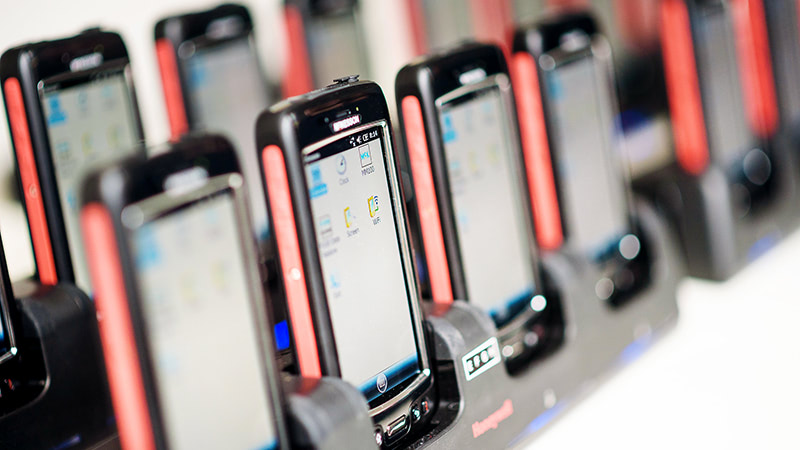Industries are increasingly adopting technology to connect workers with the data they need on the job. Technologies automate tasks, reduce human error, and speed operations.
As the tech proliferates, so does the complexity of managing, monitoring, and securing all the equipment and devices. And organizations are increasingly turning to a unified endpoint management (UEM) approach to keep a watchful eye on every connected device.
What is Unified Endpoint Management (UEM)?
It’s a strategic approach to configuring, deploying, securing and controlling IT assets including mobile computers, smartphones, printers, and other equipment endpoints in a connected, cohesive way with comprehensive visibility from a single console.
For supply chain sectors such as manufacturing, warehousing, logistics, and retail, which depend heavily on handheld mobile computers, printers, fixed scanners and sensors, wearables, and other connected devices, a UEM approach can deliver benefits in time and cost savings, security improvements, and overall visibility into all the details related to devices and equipment.
Expanding on the Benefits of Mobile Device Management (MDM)
In warehouses, distribution centers, retail stores, and even manufacturing settings, mobile computers are an essential tool for inventory management, picking, packing, and shipping, point-of-sale transactions, and customer service tasks. Businesses can have thousands of mobile devices integrated with warehouse management systems (WMS) to maximize efficiency, improve accuracy, and reduce error across operations.
As device capabilities increase and wireless connectivity becomes a must, managing and securing those devices becomes increasingly important—and complex.
Standardizing devices on the Android operating system streamlines device management and eliminates some of that complexity. But there’s still a lot of work involved in managing device fleets. The unified endpoint management market is vast and includes UEM tools from Barcoding partners like Ivanti and SOTI that streamline those tasks.
Entrusting MDM to an experienced partner like Barcoding can deliver even greater efficiency. Companies that outsource MDM reap the many benefits of expert device management:
- Device configuration and deployment
- Monitoring and managing device health
- Push updates for security, applications, and operating systems
- Total visibility into device locations, status, and usage
- Device service contract and lifecycle management
- Support desk and device troubleshooting services
And all this information can be available from a single source, so there’s no chasing down devices, people, or versions of spreadsheets to manage mobile devices.
Increasingly, customers want the same kinds of benefits they get from MDM for other connected devices in their operations—especially printers, which are now virtually everywhere in warehouses and distribution centers. As more printers are wirelessly connected, they present a new security risk and a new opportunity.
Configurations, Integrations & Security
A UEM approach can help ensure that warehouse management systems (WMS) and other applications work seamlessly with each other and across devices. UEM technology can push app installations and updates, eliminating the need for manual intervention—or worse, reliance on end users.
UEM can set geofencing parameters, helping drivers stay within designated routes. It can enhance safety by limiting access to distracting applications when a delivery vehicle is in motion. In a retail setting, lost or misplaced point-of-sale devices can be located fast, and access can be limited or disabled if needed, reducing the risk of data breaches.
Companies can monitor the battery health of devices, ensuring they are always ready for use. And maybe most important, they can easily see whether technology investments are being put to use by employees.
Seamless End User Experience & Easy IT Visibility
UEM allows IT administrators to push updates, patches, applications, configure devices, and enforce policies from a centralized dashboard. This makes troubleshooting easier and enhances the end-user experience with every connected device. For example, in a retail setting, updates to the point-of-sale system can be pushed during off-peak hours to avoid disruptions. Similarly, in a warehouse, updates to handheld devices can be scheduled during non-operational hours to avoid impacting productivity.
UEM is an increasingly important tool for managing the vast array of devices used in supply chain-related sectors. Technologies like autonomous mobile robots (AMRs), automated guided vehicles (AGVs), and other automation equipment are becoming commonplace in warehouses, manufacturing plants, and logistics operations. These devices, while improving efficiency and productivity, also bring new security and management challenges. They need to be constantly monitored and updated to ensure optimal performance and to protect against potential security threats.
The future of UEM in operations is set to become even more vital as the number of connected devices and automated equipment continues to grow. As industries increasingly adopt automation to address labor shortages, improve standardization and quality, and increase output speeds, the role of UEM will also continue to evolve and expand.
A UEM approach can help address these challenges. It can provide centralized control over all these connected devices and equipment, allowing for real-time performance monitoring, system and application updates, and security management to ensure smooth operations and maximize the return on investment in automation technologies.
And as more operations become automated, the need for standardization across devices and systems is likely to increase. UEM can play a key role in enforcing standard configurations and policies, ensuring consistency and reducing the risk of errors.
Achieving Comprehensive Endpoint Security
Protecting and securing connected mobile devices, networks, and enterprise data is a constantly moving target. Achieving fully unified endpoint management is an ambitious goal, but protecting your data deserves immediate and constant attention. Learn more about what it takes to build an enterprise mobility security strategy. Start by downloading our free whitepaper—click here or below to get your copy.







